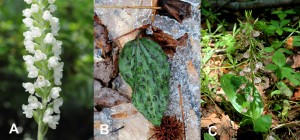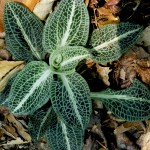by Kristen Minogue
Orchids can be notoriously picky plants – a fact which makes conserving the endangered ones a difficult job for ecologists. In a paper published this month in the journal Molecular Ecology, SERC ecologists revealed that an orchid’s survival hinges on two factors: a forest’s age and its fungi.
Roughly 10 percent of all plant species are orchids, making them the largest plant family on Earth. But habitat loss has rendered many threatened or endangered. This is partly due to their intimate relationship with the soil. Orchids depend entirely on microscopic fungi in the early stages of their lives. Without the nutrients orchids get digesting these host fungi, their seeds often won’t germinate and baby orchids won’t grow. And not every fungus works for every orchid. If there’s a mismatch, the fungus is effectively useless.
But while researchers have known about the orchid-fungus relationship for years, very little is known about what the fungi need to survive. And it turns out the fungi can be just as picky as the orchids.
Led by Melissa McCormick, SERC ecologists looked at three orchid species, all endangered in one or more U.S. states. After planting orchid seeds in dozens of experimental plots, they added the specific host fungi needed by each orchid to half the plots. Then they followed the fate of the orchids and fungi in six study sites: three in younger forests (50 to 70 years old) and three in older forests (120 to 150 years old). The entire study took four years, and they received help from Purdue University and the University of Alaska Fairbanks.
After the four years were over, the researchers discovered that it wasn’t enough for a forest to have the right fungi. It needed to have enough of the right fungi. Orchid seeds germinated only where the fungi they needed were abundant—not merely present. In the case of one species, Liparis liliifolia (lily-leaved twayblade), seeds germinated only in plots where the team had physically added fungi to the soil. This suggests that this particular orchid actually could survive in many different places, but the fungi they need don’t exist in most areas of the forest.

The three orchids in the study. A) Downy rattlesnake orchid, endangered in Florida; B) Cranefly orchid, endangered in Massachusetts and New York; C) Lily-leaved twayblade, endangered in Connecticut, New York and Rhode Island. (Melissa McCormick/SERC)
Meanwhile, the fungi displayed a strong preference for older forests. Soil samples taken from older forest plots had host fungi that were five to 12 times more abundant compared to younger forests, even where the research team hadn’t added them. They were more diverse as well. More mature plots averaged 3.6 different Tulasnella fungi species per soil sample (a group of fungi especially friendly to these orchids), while the younger ones averaged only 1.3. The host fungi had one more penchant: rotting wood. But this wasn’t that surprising to McCormick’s team, since those fungi are primarily decomposers.
All this implies that to save endangered orchids, it’s not a simple matter of planting new forests to replace the ones that were destroyed. If the forests aren’t old enough or don’t have enough of the right fungi, lost orchids may take decades to return, if they return at all.



Orchids are really special flowers, I hope that anything possible will be done in order to save them!
hello i need someone to respond to this im interested in knowing about the fungus for orchids of old forest locations, im not new at growing plants but orchids are something different and i would like to be a part of saving these exotic plants.
What a great piece. It is interesting to note that some species of orchids prefer different habitat types, the plants featured above are generally associated with woodlands. I’ve personally found that orchids native to open habitats – like dry fields, or wet meadows, superficially seem to respond favorably to disturbance – such as mowing. However, they also seem to prefer less disturbed soils (where soils remain relatively unbothered). Could the same effect be going on as in woodlands? That is, greater amounts of certain fungi are found in less disturbed (older) fields? Or are these fields (or other habitats) just “re-created” in terms of fungi abundance more quickly after disturbance than a 150 year old woodland?
There are also orchids which seem to thrive in changed environments, eventually disappearing as succession changes the environment they colonize. Would this just be a case of great good fortune? That these sites just have sufficient fungi to promote orchid growth. OR are these species more ammenable to lower levels of fungi? Perhaps there is a relationship specific to each orchid/fungus pairing in terms of the relative abundance of the fungus?
Very thought provoking article. Will have to get my hands on the paper itself…